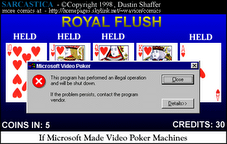Imagine you have a chunk of data and you want to present it to computers. They don't know what they're looking at unless they've been told how to handle what you show them. Every manufacturer has their own proprietary way of doing that. But, when you want to pass data between different manufactured software systems, the data must get translated into the proprietary format.
In the old world circa dcom/corba etcetera the data conformed to a hammered out standard... which, however, was also proprietary.
Along came XML and provided a very simple language with which the data structure and content could be told to any software as long as the software designers followed the XML 1.0 specification and the data thus had an opportunity to be "virtualized" or made malleable as a concept and operation. Made malleable meaning the elements of that software code could be presented in a virtual sense (a massaged copy of) appropriate to the need and uses presented... likewise virtualized.
The data still had to be converted from XML to proprietary so the proprietary system could digest the information (unless the proprietary system is also written in XML in which case even your computing language is then virtualized - but we advance tangentially, so...) but the XML could be expressed to any machine enabled to handle XML 1.0 and the machine would at least understand the data.
From that simple model, commands have been added to the data being passed universally and we now have an opportunity to use XML to virtualize operations as well as content expression and format heritage.
Today, XML theory as embodied in the VCSY IP bundle allows any proprietary code to be wrapped in an XML layer that makes expression of the data and commands within the proprietary code "arbitrary" meaning nobody cares how it's expressed as the XML processing at each machine will allow that machine to digest what is being provided.
Virtualization offers to make any operating system run on any platform with any application built out of any components and do so with no low level abstraction (programming code and methods/properties) presented to the user. That abstraction stays in the designer/developer level interfaces... of which all interfaces are also virtualized so your display works anywhere.
Now, perhaps one can see the true Vista Microsoft is giving up to the competition as they neutered their vaunted Viridian virtualization super/hypervisor.
I'm asking you eggs to think beyond competing with something like VMWare for hosting virtualized operating systems and computing resources and thinking of virtualization as a gateway to ALL operations including automation.
Virtualization has a great deal more to do with how software creation may be automated than one would think. Put simply, virtualization allows the developer to make any component take on the traits appearance and capabilities of other components as desired for the applied use. A uniform topology emerges from a pile of different parts with virtualized joints allowing each chunk to be itslef and work its own way and use the virtualization layer to present the proper user face/look and feel/capacity. The original code does not change and, in fact, may be a piece of code installed within a running application the arbitration system decided was being underutilized... the borg works. That's all the borg knows to do.
Read on McNuff:
Virtualization smirchualization wheres the bar?
Subscribe to:
Post Comments (Atom)






No comments:
Post a Comment